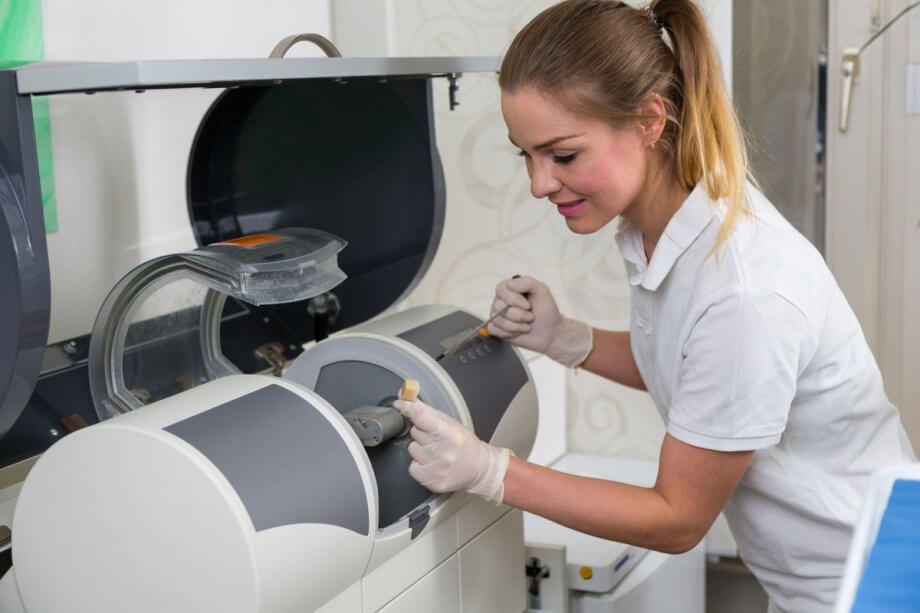My name is Dr. Kevin Coughlin owner of Ascent Dental Care and one of the first dentist in the United States to purchase a CEREC unit in the early 1990’s. A lot has happened since then and as a consumer the more you know the better off you are providing the information you receive is accurate so let’s get started.
CEREC stands for Chairside Economic Restoration of Esthetic Ceramic. It is a process of CAD CAM which means computer aided design and computer aided manufactured.
A quick trip down memory lane will provide some insight so here it goes… A crown is simply a restoration a dentist uses to cover your entire tooth. A crown is used when a tooth is weakened by large fillings, when a tooth has been root canaled so is hollow inside and susceptible to fracture, when a patient is unhappy with the appearance of their tooth such as color and or shape is less than ideal. A crown is typically done by a dentist who will reduce your own tooth between 1.5-2.5mm and he reason for this reduction is so when the crown is cemented or bonded over your existing tooth the contours and shape look natural with your adjacent teeth. For years and years all crowns were made the same way, a dentist would reduce your tooth as described above and then a dental impression would be taken to create a mould and then dental technicians would wax up a tooth and that wax pattern would get invested and placed into an oven at which time the wax would burn or melt out and gold or gold type material would be melted and centrifuged into the casting cooled milled smoothed and polished. Porcelain would then be applying to the metal substructure to look like a tooth. This process would take highly talented dental laboratory technicians up to 4-8 hours to complete this process along with many steps for error and inaccuracies.
As occurs in so many fields technology enters the picture and we have a seismic shift where a profession seems to change almost over night and Sirona company along with Siemens Company develop a technology that changes how we think and treat our patients.
Instead of taking a dental impression we now take a digital impression. Instead of pouring up an impression and making a model we design the crown, veneer or bridge right on the computer. Instead of an individual attempting to duplicate a crown by hand consistently, the computer is tireless, and the tolerance of accuracy is in the microns in which no human being can do and certainly unable to do on a consistent manor. On top of this the time has been cut down dramatically from 4-8 hours to 8-12 minutes!
So today we can create your restoration in office in a faster, more accurate manor and in many cases create a stronger more consistent restoration for our patients.
So, the question is why every dentist does not practices this way and it boils down to money and training along with a belief system that sometimes we don’t embrace change we fight it…
Only about 5% of the dentist in the United States have the CEREC technology in their office. The cost of the entire system is around $200,000.00 which is a very sizable investment for a small business which most dental offices are. Then there is training and education to adapt this technology into your dental office in which there is quite a learning curve as with any new technology and lastly the fear that within a few years the new technology will change and either new hardware and or software will be needed requiring additional investment in time and money.
Dr. Kevin Coughlin and his team at Ascent Dental Care have been providing comprehensive dental care for the entire family for more than three decades and what we have learned is you are either on the cutting edge or your left behind and short cutting your patients and providing less than optimum results and options to your most important asset your patients.
Today we can offer many different types of CEREC materials all having advantages and disadvantages and what I mean by this is the choice of materials can have a dramatic effect on the outcome or result. Today most dentist would say that the materials for a crown and or bridge fall into the following 4 categories.
- Zirconium are incredibly strong, and you see no dark metal substructure, but could have esthetic short coming so may be better for the posterior of back of the mouth.
- Ceramic are highly esthetic but if exact standards are not followed in the construction and insertion phase fracture can and will occur and many times are more appropriate in highly esthetic area such as the front of the mouth.
- Resin type restorations are the quickest to mill, cosmetic but may not last as long and many times lack the luster and shine of zirconium and ceramic.
- Porcelain fused to metal which have been around the longest and currently cannot be milled by a CEREC system, but many times will show the dark black line seen so often with crowns.
In summary no system currently is perfect after over 20 years of using different CEREC technologies in my opinion patients are looking for options and the ability to Believe Like and Trust their dentist to have all the technologies available and the experience to guide them on what is the best options for their problem. We believe the Ascent Dental Care team offers all of this and much more.
You can learn more at www.ascentdentalcare.com or info@ascentdentalcare.com.

